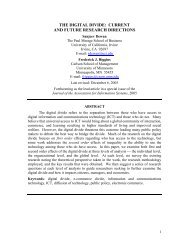Agent-Based Modeling to Inform Online Community Theory and ...
Agent-Based Modeling to Inform Online Community Theory and ...
Agent-Based Modeling to Inform Online Community Theory and ...
You also want an ePaper? Increase the reach of your titles
YUMPU automatically turns print PDFs into web optimized ePapers that Google loves.
ers who converse <strong>to</strong> ask <strong>and</strong> answer questions, exchange opinions <strong>and</strong> social support, <strong>to</strong> develop<br />
personal relationships <strong>and</strong> <strong>to</strong> enjoy each others’ company. Without conversation, these communi-<br />
ties would vanish. Even in online games like World of Warcraft or production-oriented communi-<br />
ties like Wikipedia, members depend upon conversations <strong>to</strong> coordinate their work <strong>and</strong> <strong>to</strong> develop<br />
commitment <strong>to</strong> the group.<br />
Even though communication is central <strong>to</strong> most online communities, <strong>to</strong>o much communica-<br />
tion or the wrong kind can threaten them. <strong>Inform</strong>ation overload fueled by high message volume<br />
<strong>and</strong> heterogeneity of <strong>to</strong>pics can drive people away from online communities (Butler 2001, Jones et<br />
al. 2004). High message volume can be especially problematic when much of the conversation is<br />
off-<strong>to</strong>pic or when the community is organized <strong>to</strong> cover many different <strong>to</strong>pics. Although many<br />
communities are organized around specific <strong>to</strong>pics, people in them often engage in personal, off-<br />
<strong>to</strong>pic conversations that have nothing <strong>to</strong> do with the nominal <strong>to</strong>pic. For example, a large minority<br />
of messages in a discussion group organized around depression may have nothing <strong>to</strong> do with de-<br />
pression (http://discussions.seniornet.org, Wright 2000), <strong>and</strong> messages in investment discussion<br />
groups may have little <strong>to</strong> do with finances (Gu et al. 2007). For members interested only in the<br />
nominal <strong>to</strong>pic of the community, off-<strong>to</strong>pic messages are an irritation that can drive them away.<br />
High message volume is also problematic in communities that encourage conversation across a<br />
wide range of <strong>to</strong>pics. As Butler (1999) notes, in communities treating many <strong>to</strong>pics, messages inter-<br />
esting <strong>to</strong> some members are likely <strong>to</strong> be off-<strong>to</strong>pic <strong>and</strong> uninteresting <strong>to</strong> others.<br />
The default view in most online discussion communities shows every member all messages,<br />
organized either in chronological order or in threads. To deal with problems of high message vo-<br />
lume <strong>and</strong> off-<strong>to</strong>pic conversation, designers <strong>and</strong> managers of online communities have augmented<br />
the default with techniques for moderating the discussion. A common practice is community-level<br />
moderation, in which case human modera<strong>to</strong>rs or software agents block or remove inappropriate or<br />
off-<strong>to</strong>pic messages (Figallo 1998, Lampe <strong>and</strong> Johns<strong>to</strong>n 2005). A message is available either for<br />
everyone visiting the site or for no one. <strong>Community</strong>-level moderation can be performed ex ante, by<br />
8
















